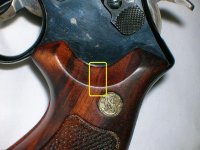Please post a picture of the crack in the stock/grip and your opinion if it represents a significant structural weakness to the overall stock/grip or is it more cosmetic.
I have posted a few times about repairing cracks in stocks/grips with the method cited by BC38. This technique works well for repairs that lean towards the cosmetic repair. If there is a significant structural weakness I would consider using another method. The beauty of this repair is that it's simple and undetectable in my experience since the cracks I've dealt with run with the grain.
1. Strip the finish off the grips.
2. Lightly sand the grips over a piece of white paper and save the wood dust.
3. Use a thin "Super Glue" (cyanoacrylate).
4. Have a fine grit sandpaper available.
5. If possible slightly (gently) separate the crack by a miniscule amount.
6. Work quickly from this point on. Apply super glue over/into the crack, enough to penetrate the full thickness of the crack and come out on the back side of the stock/grip. There should be a small amount of excess super glue on the outside of the grip/stock over the crack. Work quickly for the next steps.
7. Wipe off any excess Super Glue on the back side of the grip.
8. Place the saved wood dust over the Super Glue laden crack on the outside of the grips. Some of it will stick to the excess Super Glue.
9. Sand along the grain of the wood with fine grit sand paper over the Super Glue/wood dust slurry until it is smooth and blended with the remainder of the grip.
10. When done the crack should look like natural wood grain in the stock/grip.
Here's one in which there was a vertical crack at the top forward portion of this stock (a little forward and above the emblem):
[URL=http://s1383.photobucket.com/user/truebunk1/media/78e76dff-3f4f-4982-8fcf-e7541be40321_zpshxjprd72.jpg.html]

[/URL]

 [/URL]
[/URL]
